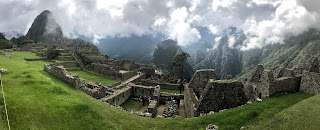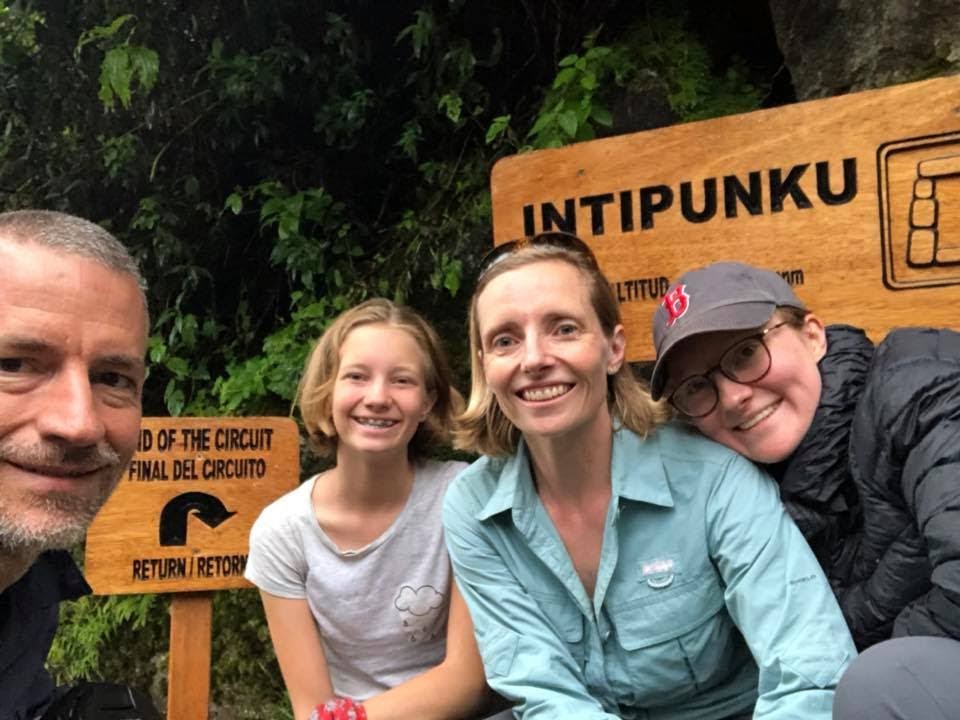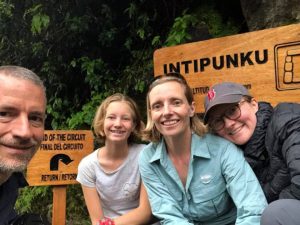I’m not sure where to start with our day at Machu Picchu… I feel like we have done an enormous amount today, all made so much richer by the experience of completing the Inca Trail.
It was a race to start the day… 3:30 wake up, packed and out of the tents by 3:50, breakfast and out of the camp by 4:10. Our tents and were heading down the mountain before we were. It literally took our porters minutes to get out – these are a well oiled machine! We then sat in the rain about 200m from our camp site, waiting for the final checkpoint to open at 5:30… all the rush was just to get a good spot in the queue!
The morning was cloudy with a misty rain, so we weren’t able to see the views as the sun rose over the mountains.
The path was narrow, wet, and with nothing but a sheer drop beside us… it made for a very focused hike! Again, the 2 hour prediction to reach the Sun Gate took us an hour.
Just before we reached the Sun Gate we had been warned of the ‘Monkey Stairs’. These stairs are so steep that you have no choice but to climb them like a ladder… a final test at the end of the trail!
The Sun Gate is the official end of the Trail, and entry to the Machu Picchu site. It was quite emotional to reflect on what theGradyBunch had taken on and achieved together. An awesome experience, well beyond expectations, making memories that we will treasure forever.
Our group reconvened and we did the final walk down to Machu Picchu together. Along the way we saw the Temple of the Mother Earth, where people left offerings of coca leaves, and guinea pigs would have been sacrificed.
Arriving at the Machu Picchu ruins from the mountains above was spectacular. No photo does the ruins, or the surrounding mountainous landscape justice.
Machu Picchu ‘Ancient Mountain’ is the name given to the ancient city, built by Pachakuti in 1450 on the most ancient of all mountains – Machu Picchu. The site was selected because of the access to materials, the spring water, and the surrounding holy mountains. The city was adapted to the shape of the mountains to minimise the impact on Mother Earth. The spring water is still running in 16 of the 22 fountains today.
The Inca people were always looking for balance and complementary elements, and Machu Picchu was complemented by Huana Picchu that towers above the site (left of the photo below). It is believed that Machu Picchu was the gate to the upper world at 2400m, and showed the power of the Inca people to their enemies.

The site was abandoned quickly in 1547 after the Spanish arrived, so remains unfinished. The Spanish took the silver and gold during the civil war, so the last Inca ‘Manco Inca’ tried to rebel. In 1537 he came from Ollantaytambo to Cusco and destroyed all the bridges behind him, hiding the gold and silver as he went.
In 1902, a local person found it while camping in the hills. By this time, it was heavily overgrown and dwell hidden. In 1911, Hiram Bingham, a Professor from Yale was brought to the site after previous expeditions, by a local 12 year old boy. He completed further exploration funded by Yale and National Geographic in the years that followed.
At the time, Hiram Bingham found many Inca tombs of short Andean people. He originally thought these were girls, and so began the folklore of the human sacrifice.
Apparently, Hiram Bingham found pottery, but never silver and gold at the site. In 2010, it was estimated that only 7% of the treasures from Machu Picchu had been returned to Peru. In 2007, the site was declared one of the 7 new wonders of the world. Today it is believed that Machu Picchu is sinking because of it’s location on 2 geological faults.
Part of the UNESCO World Heritage listing requires that some areas are left untouched to show evidence of how Machu Picchu was found. Today, about 70% is original, 20% restored, and 10% remains untouched underground for future archaeological research.
One of the most striking central sites is the Temple of the Sun. The Temple of the Sun has 2 windows that when the sun shines through at a certain angle, and is aligned to the Sun Gate the local people would know it was the Summer solstice, and at another point for the Winter Solstice. This would guide their farming activity. Most temples face East, however this faces towards the mountains for worship.
The Temple of the Sun is a striking example of Imperial quality Inca building – with smooth rock faces, and perfectly formed joints. This is in contrast to the rustic stonework found elsewhere.
It was also known to be the priests lodging because of the ceremonial knives and other pottery found there, and the double-jamb door that led to the area. The lower class people lived further up the hill, in more simple surrounds.
The Temple of the Pacha Mama beneath holds the tomb of Pachakuti. It also features the Chakana symbol that is prominent in many Inca sites.
The terraces at Machu Picchu have 3 different purposes – some for farming, some as a retaining wall, and some as decoration.
It is estimated that 500 people lived at Machu Picchu, a calculation based on the volume of water that flowed to the site. In festival time, this would swell to 5000 people.
Living rooms were identified by the quality of furs and blankets found, suggesting it was a comfortable space for families and the community to meet.
There is evidence of how the Inca people split the rocks. They would find a natural fault, and chip holes beside it. Small pieces of wood were inserted, and cold water used to expand the wood until the force split the rock. When the walls were built, rocks were hand polished with water.
Above the Temple, there is the half symbol of a Chekana made of stone. During the Winter Solstice, this creates a shadow to complete the Chekana.
There is also a very special and sacred rock that points to the Southern Cross. Again, this highlights the significance of the constellation to the Inca people. I never knew how much they share my pride and love for our Australian constellation 🙂
In the centre of the site is the sundial, that showed the time, days, weeks and years for the Inca people. They were ingenious in the way they measured and captured information.
We finished our trip to Machu Picchu with a hike up to the Inca Bridge, around the back of the mountain. The bridge was literally on the side of a cliff, with a path leading upwards around the cliff. Thankfully none of this was accessible, as the path to view the site was probably the most treacherous we had hiked over the 4 days.
Of course, no trip to Machu Picchu was ever going to be complete without a llama or two… and without the llama socks that were bought especially for this occasion
So, after 4 days of ruins, history, highlands, jungle, sun, rain, ascents, descents, stairs, slopes, wildflowers, llamas, and a 4215m pass we said goodbye to the Inca Trail and Machu Picchu. Any visit to Machu Picchu is inspiring and fascinating… hiking there as a family was truly one of the best and most memorable experiences we will ever have. It challenged all of us in different ways, and we each will have taken something different from it. We share a sense of achievement, and connection to our planet and history like never before.


Comments are closed